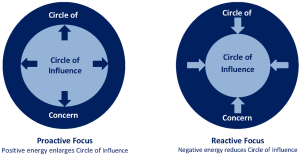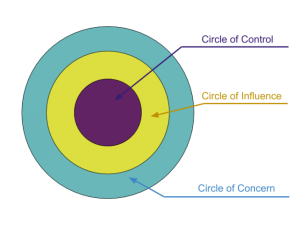A tool to develop assertiveness and stress-management
Objectives
- Students will consider how to use the Circle of Influence tool
- Students will practice using the Circle of Influence tool in their life
Circles of Influence is a great tool for resilience. Of all the good suggestions in The Seven Habits of Highly Effective People, Habit 1: Be Proactive, is particularly useful when you feel powerless against life’s forces. It can be helpful when you examine what you can do, instead of focusing on worries. First, you must notice and recognize your concerns; then, among those concerns, determine what you can control.
Each “circle” takes up space and energy in our lives. As you put energy towards your Circle of Influence, that area will grow, and your Circle of Concern will shrink.

- Poster Paper or Whiteboard
- Post-It Notes (6 per student)
1. Give students a blank sheet of paper, fold it in half, and have them draw two pictures: A picture of what makes a good day, and a picture of what makes a bad day. These should be ‘realistic’ days, not an ‘anything is possible’ day.
2. Spend several minutes having students talk through their pictures with a partner or group of three. This will bring up common themes, as well as providing ideas for the main exercise.
3. Share with students that you will be working through a model that can help them be proactive in the face of challenges they might encounter. Share that their ideas about a good day and a bad day are there to get their brains working, and they can use those ideas, or any other ideas that they have.
4. Next, draw a large circle (as big as you can) on the whiteboard or poster paper. This is the Circle of Concern. Inside it are all the things you might be bothered or concerned about.
5. Draw a smaller circle inside the big circle. This smaller circle is called the Circle of Influence. Inside this circle are all the things you have control over, or can do something about.
6. Pass out 6 Post-It notes to each student. Ask them to choose three important aspects from their Good Day – things that might make the most long term positive difference to their day. Write each thing on one Post-it note.
7. Similarly, from the Bad Day, choose three aspects of the day—things that were really key to that bad environment. Write each thing on one Post-it note.
8. Invite students to place their Post-It notes into the circles depending on whether they think that they have control/influence over it or not?
9. Once all the Post-it notes are in the circles, stand back and see where you are. If possible, have students cluster around the diagram so they can see and respond to the conversation.
If you are breaking this session into two parts. Here is a natural stopping point.
10. First, have a look at what is in the Influence circle. What are they? Ask and discuss why and how these things are in their control. Sometimes this can be an interesting discussion, often the same things can be put inside and outside of our control depending on perspective, etc.. If you’d like, take new Post-It’s and re-write the outcome of the discussion to better differentiate how things could be in the circles of concern or influence.
11. Next, have a look at what is in the Circle of Concern - find out why these things are here. What is outside of our influence? And Why?
This is where the work is. These are usually the sticky areas that cause us the most grief. Other people, unclear objectives, shifting priorities, unwieldy systems. The real messy stuff that we all struggle with.
For each of these things - the aim is to find ways to bring them into the inner circle. What is it that you could do about this?
You may not be able to bring them in entirely - but we are looking for are options for something that can be done.
12. It really pays to spend some time here. Go through each one. Keep going until you exhaust the options. It can be surprising what options come up, even when we think we have exhausted them, if we just ask, 'What Else?’
13. Eventually, you will reach the brick walls and you may find that there are still some things outside of your control.
14. Discuss how this model shows that where and how we spend our energy can enlarge or shrink the circles. Each area takes up space and energy in our lives, so where we put our energy will take up more space.

This lesson builds on the Good Day / Bad Day framework. You may find more relevance by building on another framework such as:
• Good Day at school/group and Bad Day at school/group
• Healthy Relationships and Unhealthy Relationships
• A hard challenge coming up
1. The point of this exercise is NOT to prove anyone’s idea wrong. Be careful if you’re trying to convince a student that they do have control over something in their life. We do not know the complete picture and dynamics of a student’s life.
2. Notice the difference between the “ If only I had…” versus “I can be…” statements. Focusing on what you don’t have is disempowering, focusing on what you can do is proactive and empowering.

3. In more advanced models there is a third section of the circle, a breakout between the circle of control and the circle of influence. If students are struggling to place things squarely in one of the two sections—feel free to share this more nuanced model.
4. As with any tool that you introduce to students, the power lies in re-use and application at other times. Don’t expect students to suddenly use this model spontaneously. Expect that you will need to coach and guide students to use this in other applications before students will initiate its use.
1. To wrap up the exercise ask students to commit to at least one action they can take in the next week.
2. Remind students that having stuff you care about, but which lies outside of your influence just feels bad! Full Circles of Concern and tiny Circles of Influence feel terrible. Finding ways to make the Circle of Influence bigger, by working to parse out the things that you CAN have control over - can make you feel happier and more motivated.
3. We all need to find ways of dealing with the reality of things outside of our influence. We can’t stop it from raining, but we could see the rain with a different perspective or use something to keep us dry!
4. Viktor Frankl, a Holocaust survivor wrote “Everything can be taken from a person but one thing…to choose one’s attitude in any given set of circumstances, to choose one’s own way.” Do you agree or disagree with his idea? How does it connect to the Circle of Influence model?